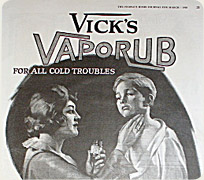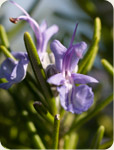Newsletters » Vicks Alternative

Vicks® VapoRub® ~ Essential Oil Alternative
My well-meaning mother rubbed Vicks® on my back and chest and put it into a steam vaporizer for me to breathe when I suffered respiratory ailments. I doubt she ever thought about what was in it – "everybody" used it. After I married, my husband and I began to question some of what the generation before us had taken for granted (vaccinations, antibiotics and so on). When we were confronted with respiratory issues, we looked into Vicks®, and this, in a nutshell, is what we found.
confronted with respiratory issues, we looked into Vicks®, and this, in a nutshell, is what we found.
Vicks® VapoRub® Ingredients (Vicks Official Website):
Camphor 4.8%
Eucalyptus 1.2%
Menthol 2.6%
Cedarleaf oil
Nutmeg
Special Petrolatum
Thymol
Turpentine
It is not clear from their list whether Vicks® uses natural or synthetic chemical components. My guess is that they are synthetic, but even if the ingredients are natural components, at least a few of them are isolated chemical components from naturally occurring essential oils. By isolating chemical components, pharmaceutical companies are able to produce consistency. It's the inconsistency in naturally occurring plant-based essential oils that make them superior to antibiotics in fighting things like antibiotic resistant staph. The chemical makeup of pure, unadulterated essential oils varies from batch to batch (growing season to growing season), so the disease-causing pathogenic micro-organisms (fungal, bacterial, viral) cannot form a resistance to it. Also, isolating one component of an oil may make it less balanced and may even make it toxic, while in its natural state, it may be very beneficial.
LET'S TAKE A LOOK AT VICKS® VapoRub® INGREDIENTS
Camphor is usually a low-grade oil that comes from China. Even though you don't expect to feed Vicks® to a child, it may be beneficial to know that they can be poisoned by it if accidentally ingested.
"Poisoning by camphor is associated with an initial excitatory phase, with vomiting, diarrhoea and excitement, followed by NS [nervous system] depression and death. A characteristic odour of camphor is present on the breath. The symptoms may appear 5-90 min after ingestion depending on the product ingested (solid or liquid). Oral and epigastic burning sensations, nausea, and vomiting usually occur early. The onset of convulsions may be sudden and without warning, or may be preceded by confusion and irritability, neuromuscular hyperactivity, and jerky movements of the extremities. Convulsions may be followed by coma, apnoea, and death."
Chemical Safety Information
Let's look at Thymol. This is the dictionary definition:
"Thymol is a monoterpene phenol derivative of cymene, C10H14OH, isomeric with carvacrol, found in oil of thyme, and extracted as a white crystalline substance of a pleasant aromatic odor and strong antiseptic properties. It is also called 'hydroxy cymene'." (from Webster's 1913 dictionary)
So, thymol is isolated from thyme essential oil. Now look at the toxicology report on thymol and ask yourself if you want to put it on yourself or your child.
Thymol Toxicology:
Harmful if swallowed, inhaled or absorbed through the skin. Eye, skin and respiratory irritant. Eye contact may cause serious harm.
MSDS Data
On the other hand, the pure, unadulterated essential oil of Thyme in its whole, natural state is actually approved by the FDA for internal usage. It is generally regarded as safe. It is recommended that thyme essential oil be diluted with a vegetable oil when applied to the skin, but it certainly is not harmful.
Cedar Leaf Oil
Taken in excess, Cedar Leaf oil (Thuja occidentalis) can produce unpleasant results. It is officially listed as an abortifacient (a drug or agent causing abortion) and convulsant in overdose. The leaf oil is considered toxic, causing hypotension (low blood pressure), and convulsions. Fatalities have been reported. This essential oil is not commonly used by aromatherapists, and it does bear these cautions: Do not use during pregnancy. Do not use without medical supervision.
While it is unlikely that one might experience unpleasant results, I'd question if the addition of an oil with such a reputation is necessary.
As an alternative, Cedar Wood essential oil on the other hand is approved by the FDA and generally regarded as safe, even taken internally. It doesn't have such a dreadful warning, and is known to be effective for tuberculosis, bronchitis, respiratory issues, congestion, sinusitis and so on.
Menthol is the main chemical component in Peppermint essential oil. Perhaps there's nothing wrong with isolating menthol, but given a choice, I'd like to use the oil in its most natural state, Peppermint.
Nutmeg essential oil supports the adrenals and immune system, and fights bacterial infections. If Vicks® uses natural nutmeg essential oil, great!
Next, let's look at Petrolatum. There's a lot that can be said about the hazards of putting a petroleum product on your skin. Here's one report that might help open our eyes.
Petrolatum
Petrolatum Health Report
"Among the studies linking the petrolatum impurity PAHs [polycyclic aromatic hydrocarbons] to breast cancer is a Columbia University study in which researchers found that the breast tissue of women with breast cancer was 2.6 times more likely to contain elevated levels of PAHs bound to DNA (called DNA adducts) than the breast tissue of women without breast cancer (Rundle et al. 2000). Serious questions need to be answered over the safety of petrolatum or petroleum jelly as it is more commonly known."
Skin Deep Report on Petrolatum
The following is quoted from the Environmental Working Group's website:
"Breast cancer and impurities. EWG's [Environmental Working Group's] assessment of product ingredient labels and data on cancer-causing chemicals identified three common impurities in personal care products that are linked to mammary tumors in animal studies — ethylene oxide, PAHs [polycyclic aromatic hydrocarbons], and 1,3-butadiene. The ingredients for which these impurities are of concern are used in one of every four personal care products on the market."
"Among girls born today, one in eight is expected to get breast cancer and one in 30 is expected to die from it (NCI 1996, 1997, 2000). A review by scientists from Lawrence Berkeley National Laboratory shows that as many as one of every five chemical carcinogens causes mammary tumors in laboratory studies, indicating that the breast is more sensitive to carcinogens than almost any other tissue in the body (Gold et al. 1991). EWG's identification of three impurities linked to breast cancer does not represent a full accounting of possible mammary carcinogens in personal care products. Instead, it is a partial accounting based on the National Toxicology Program's assessment of mammary carcinogens (NTP 2000) and other sources in the peer-reviewed literature. Further study would likely identify additional ingredients in personal care products that raise concerns with respect to breast cancer."
"PAHs, or polycyclic aromatic hydrocarbons, are common contaminants in petrolatum, also called petroleum jelly and sold under well-known brand names like Vaseline. Petrolatum is found in one of every 14 products on the market (7.1 percent of the products assessed by EWG), including 15 percent of all lipstick and 40 percent of all baby lotions and oils. FDA restricts petrolatum in food to no more than 10 parts per million, and requires petrolatum used in food packaging or drugs to meet impurity restrictions for PAHs (21 CFR 178, 21 CFR 172.880)."
 FINAL COMMENTS: Back to the Ingredient List
FINAL COMMENTS: Back to the Ingredient List
I decided to take the ingredient list and make my own product. Instead of Camphor, I used Rosemary (Rosmarinus officinalis 1,8 Cineol CT), which is 22% camphor in chemical makeup. I used Eucalyptus radiata, which is anti-infectious, antibacterial, antiviral, expectorant, and anti-inflammatory. Eucalyptus is an antimicrobial oil studied for its action against viruses and is used extensively for respiratory infections and is helpful for conjunctivitis, sinusitis and bronchitis. For the menthol, I used Peppermint, which is 38-48% menthol and is useful for many ailments and very effective for respiratory infections and asthma. Peppermint is a decongestant, anti-infectious, anti-bacterial, anti-fungal and mucolytic. I used true Thyme instead of a laboratory's altered version, thymol, and Pine essential oil in lieu of turpentine. Instead of the petrolatum, I dilute my mixture with Coconut oil, which is compatible to human skin and quickly absorbed.
Vicks® Ingredients vs. Suggested Essential Oil Ingredients:
Camphor - Rosemary ct cineol essential oil
Eucalyptus - Eucalyptus radiata essential oil
Menthol - Peppermint essential oil
Cedarleaf oil – Cedarwood essential oil
Nutmeg – Nutmeg essential oil
Special Petrolatum – Any of these are good alternatives: Jojoba, Emu, Coconut, Almond, Avocado, Olive
Thymol - Thyme essential oil
Turpentine - Pine essential oil
I believe this pure essential oil blend is a far superior product. It can be inhaled by using a micro-mist diffuser or applied topically with proper dilution to the neck, chest and/or back.
In considering what to call this blend, I decided on "Mom's Remedy" in honor of all the moms who endeavor to provide the best for their children.



12 Newsletter Comment
Looks like a wonderful alternative. I look forward to sharing this information with other moms.
April
Thank you for telling what dangerous items are in Vicks. Yes, I've used it a lot on myself and my children as my mother die. I want to try your product.
Martha
Linda, you are amazing! :)
Regina
Thanks for the article and for making one superior to the Vicks we used in the past. God bless!
Pedro
Thanks Linda for the info. I suffer from respitory problems every winter, so this is good to know. I WILL be ordering some. Blessings to you
Sharon
Thank you for the information! As I learn more, I am reducing the harmful effects of chemicals on my body and living a healthier life!
Jana
THANK YOU LINDA FOR THAT INFO. SURE DIDN'T KNOW THAT.
Judy
I will enclose a copy of your newsletter with the Mom's Remedy I am sending to my granddaughter for her baby girls. I am so thankful for your diligence in informing us of the benefits essential oils.
Norma
I'm looking forward to trying this if colds make their unwanted appearance.
Alice
We have been using for over a year and LOVE it... In September we were at a church convention, and our 14 year old son had a terrible head cold and could not breathe through his nose. I rubbed Moms remedy on is neck and a bit under his nose... then at least he could breathe through his nose...
Denise
Linda, Fantabulous!!! Thank you for all your thorough research, factual explanation and great new product!
Therese
Awesome, thank you so much for sharing!!
Jamie